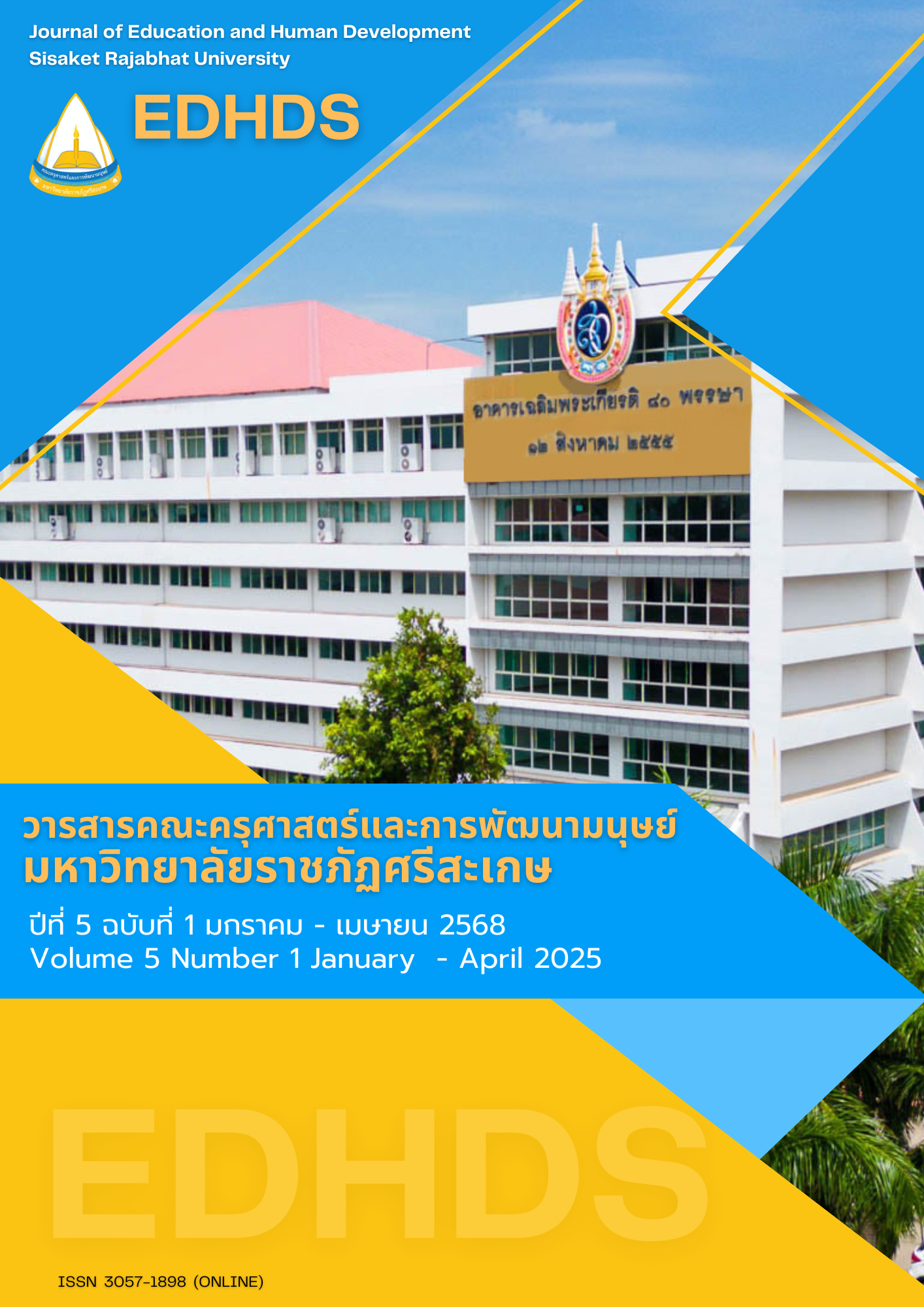การพัฒนาโซเชียลคอมเมิร์ซเพื่อการท่องเที่ยวเชิงวัฒนธรรมสำหรับวิสาหกิจชุมชน บ้านเห็ดโคนน้อยเมืองนนท์ อำเภอเมืองฯ จังหวัดนนทบุรี
คำสำคัญ:
โซเชียลคอมเมิร์ซ, ผลิตภัณฑ์ชุมชนอย่างยั่งยืน, ทุนทางวัฒนธรรม, วิสาหกิจชุมชนบทคัดย่อ
การวิจัยนี้เป็นการวิจัยเชิงผสมผสาน มีวัตถุประสงค์การวิจัยเพื่อศึกษาแนวทางการในปรับปรุงและพัฒนารูปแบบการใช้งานโซเชียลคอมเมิร์ซสำหรับวิสาหกิจชุมชน และเพื่อศึกษาแนวทางในการปรับกลยุทธ์ทางด้านการตลาดออนไลน์ในโซเชียลคอมเมิร์ซสำหรับวิสาหกิจชุมชนได้อย่างเหมาะสม โดยการสัมภาษณ์เชิงลึกจากสมาชิกวิสาหกิจชุมชนบ้านเห็ดโคนน้อยเมืองนนท์ อำเภอเมืองฯฯ จังหวัดนนทบุรี โดยการวิจัยครั้งนี้ผู้ให้สัมภาษณ์ จำนวน 10 คน เครื่องมือที่ใช้ คือ แบบสัมภาษณ์กึ่งโครงสร้าง ซึ่งได้ผ่านการตรวจสอบความตรงเชิงเนื้อหา ทำการวิเคราะห์ผลโดยใช้โปรแกรมวิเคราะห์ทางสถิติด้วยคอมพิวเตอร์ ในการวิเคราะห์ข้อมูลเชิงปริมาณ สถิติที่ใช้ในการศึกษา คือ ค่าร้อยละ ค่าเฉลี่ย โดยนำเสนอผลการศึกษาในรูปแบบตารางประกอบการบรรยาย และแสดงข้อมูลทางสถิติวิเคราะห์ รวบรวมข้อมูลในเดือนกันยายน 2567
ผลการวิจัยเรื่องการพัฒนาโซเชียลคอมเมิร์ซเพื่อการท่องเที่ยวเชิงวัฒนธรรมสำหรับวิสาหกิจชุมชนบ้านเห็ดโคนน้อยเมืองนนท์ อำเภอเมืองฯ จังหวัดนนทบุรี มีดังนี้ 1) ข้อมูลทั่วไปของผู้ให้สัมภาษณ์ เป็นสมาชิกวิสาหกิจชุมบ้านเห็ดโคนน้อยเมืองนนท์ ประกอบไปด้วย กรรมการบริหารวิสาหกิจชุมชนบ้านเห็ดโคนน้อยเมืองนนท์ อำเภอเมืองฯ จังหวัดนนทบุรี จำนวน 6 คน และสมาชิกวิสาหกิจชุมชน บ้านเห็ดโคนน้อยเมืองนนท์ อำเภอเมืองฯ จังหวัดนนทบุรี จำนวน 4 คน รวม 10 คน พบว่า ส่วนใหญ่เป็นเพศหญิง 10 คน ประสบการณ์การทำงานเฉลี่ย 7 ปี 2) รูปแบบการใช้สื่อสังคมออนไลน์เชิงพาณิชย์ พบว่า ใช้สื่อสังคมออนไลน์ที่หลากหลายจากผลการวิจัยเชิงคุณภาพ แบ่งออกเป็น 4 ส่วน ดังนี้ ส่วนที่ 1 รูปแบบการตลาดแบบเดิม พบว่า ไลน์กลุ่มถือได้รับความนิยมในการทำการตลาดแบบเดิม และติดต่อสื่อสารกับสมาชิกของวิสาหกิจชุมชนบ้านเห็ดโคนน้อยเมืองนนท์ มากที่สุด ร้อยละ 80 ส่วนที่ 2 ความต้องการพัฒนาการตลาดแบบใหม่ พบว่า ติกตอก ได้รับความนิยมมากที่สุด ร้อยละ 80 ส่วนที่ 3 สื่อมัลติมีเดียที่ต้องการนำเสนอตลาดเนื้อหา พบว่า สื่อมัลติมีเดียที่ได้รับความนิยมมากที่สุด คือ สื่อภาพ ร้อยละ 80 ส่วนที่ 4 ผลิตภัณฑ์ยอดนิยมที่ต้องการนำเสนอทุนทางวัฒนธรรม พบว่า ผลิตภัณฑ์ยอดนิยมที่ต้องการนำเสนอทุนทางวัฒนธรรมมากที่สุด คือ แหนมหมู ร้อยละ 70 3) การปรับปรุงและพัฒนารูปแบบการใช้สื่อสังคมออนไลน์เชิงพาณิชย์ ได้แก่ เฟซบุ๊ก อินสตาแกรม ยูทูบ และ ติกตอก 4) การปรับกลยุทธ์การตลาดออนไลน์สำหรับวิสาหกิจชุมชน โดยกำหนดแนวทางการพัฒนากลยุทธ์ในแต่ละทางเลือกโดยใช้การวิเคราะห์ TOWS Matrix ออกมาเป็น 2 กลยุทธ์ ดังนี้ กลยุทธ์ที่ 1 กลยุทธ์ภาพลักษณ์ตราผลิตภัณฑ์เพื่อประชาสัมพันธ์ และการโฆษณาในสื่อสังคมออนไลน์เชิงพาณิชย์ และกลยุทธ์ที่ 2 กลยุทธ์การสื่อสารเพื่อสร้างความสัมพันธ์ลูกค้าใน สื่อสังคมออนไลน์เชิงพาณิชย์สำหรับวิสาหกิจชุมชนยุคดิจิทัล
เอกสารอ้างอิง
จุฑามาศ แก้วพิจิตร อัชกรณ์ วงศ์ปรีดี และฉัชเฉลิม สุทธิพงษ์ประชา. (2560). รายงานการวิจัยเรื่องการพัฒนากลยุทธ์ในการยกระดับผลิตภัณฑ์เชิงวัฒนธรรมให้เป็นตราผลิตภัณฑ์ระดับโลก. กรมส่งเสริมวัฒนธรรม กระทรวงวัฒนธรรม.
นฤศร มังกรศิลา และนุจรี บุรีรัตน์. (2561). การบริหารลูกค้าสัมพันธ์เพื่อให้ได้ข้อมูลย้อนกลับที่ดีจากพาณิชย์อิเล็กทรอนิกส์และสื่อสังคมออนไลน์ในธุรกิจร้านอาหาร. วารสารจันทรเกษมสาร, 24(46), 65-81.
โยธิน แสวงดี. (2559). ประชากร การคำนวณขนาดตัวอย่าง และวิธีการสุ่มตัวอย่าง. https://ipsr.mahidol.ac.th/
วิสาหกิจชุมชนบ้านเห็ดโคนน้อยเมืองนนท์ อำเภอเมืองฯ จังหวัดนนทบุรี. (2566, 14 กันยายน). ความเป็นมาและข้อมูลเกี่ยวกับวิสาหกิจชุมชนบ้านเห็ดโคนน้อยเมืองนนท์. นนทบุรี.
Abbott, W., Donaghey, J., Hare, J., & Hopkins, P. (2013). An Instagram is worth a thousand words: an industry panel and audience Q&A. Library Hi Tech News, 30(7), 1-6.
Abed, S. S. (2020). Social commerce adaption using TOE Framework: An empirical investigation of Saudi Arabian SMEs. International Journal of Information Management, 53. https://doi.org/10.1016/j.ijinfomgt.2020.102118.
Basu, S. (2018). Information search in the internet markets: Experience versus search goods. Electronic Commerce Research and Applications, 30(2018), 25-37.
Bourdieu, P. (1986). The forms of capital. In J. G. Richardson (Ed.), Handbook of theory and research for the sociology of education (pp. 241-258). Greenwood.
Chaffey, D., & Smith, P. R. (2022). Digital marketing excellence: planning, optimizing and integrating online marketing. Routledge.
Chai, B. S., Chae, T., & Huang, A. I. (2024). Evaluation of Educational YouTube Videos for Distal Radius Fracture Treatment. Journal of Hand Surgery Global Online, 6, 382-387.
Elkington, J. (1997). Cannibals with forks: The triple bottom line of 21st century business. Capstone.
Gao, Y., Liu, F., & Gao, L. (2023). Echo chamber effects on short video platforms. Scientific Reports, 13(1) doi:10.1038/s41598-023-33370-1
Hart, S. L. (1995). A natural-resource-based view of the firm. The Academy of Management Review, 20(4), 986-1014.
Hassaro, K., & Chailom, P. (2023). Motives of social media use for online marketing: A uses and gratification approach. International Journal of Computing and Digital Systems, 13(1), 415-425. doi:10.12785/ijcds/130134
Huang, Z., & Benyoucef, M. (2017). The effects of social commerce design on comsumer purchase decision-making: An empirical study. Electronic Commerce Research and Applications, 25, 40-58.
Khalaf, A., Radhi, A., Al Mascati, M., Moosa, M., Hamdan, A., & Syed-Ahmad, S. (2023). The impact of social media on E-commerce and marketing. doi:10.1007/978-3-031-26956-1_15
Kizildag, M., Altin, M., Ozedmir, O., & Demirer, I. (2017). What do we know about social media firms’ financial outcomes so far?. Journal of Hospitality and Tourism Technology, 8(1), 39-54.
Kotler, P., Kartajaya, H., & Setiawan, I. (2017). Marketing 4.0: Moving from traditional to digital. Wiley.
Kwangsawad, A. & Jattamart, A. (2022). Overcoming customer innovation resistance to the sustainable adoption of chatbot services: A community-enterprise perspective in Thailand. Journal of Innovation & Knowledge, 7, 1-13.
Lamont, M., & Lareau, A. (1988). Cultural capital: Allusions, gaps, and glissandos in recent theoretical developments. Sociological Theory, 6(2), 153-168.
Lemon, K. N., & Verhoef, P. C. (2016). Understanding customer experience throughout the customer journey. Journal of Marketing, 80(6), 69-96.
Lin, X., Li, Y., & Wang, X. (2017). Social commerce research: Definition, research themes and trends. International Journal of Information Management, 37, 190-201.
Meng, L. M., Kou, S., Duan, S., & Bie, Y. (2024). The impact of content characteristics of Short-Form video ads on consumer purchase Behavior: Evidence from TikTok. Journal of Business Research, 183. https://doi.org/10.1016/j.jbusres.2024.114874.
Moore, J. F. (1996). The death of competition: Leadership and strategy in the age of business ecosystems. Harper Business.
Osatuyi, B., & Qin, H. (2018). How vital is the role of affect on post-adoption behaviors? An examination of social commerce users. International Journal of Information Management, 40, 175-185.
Pham, L. H., Woyo, E., Pham, T. H. and Truong, D. T. X. (2022). Value co-creation and destination brand equity: understanding the role of social commerce information sharing. Journal of Hospitality and Tourism Insights.
Ryan, D. (2016). Understanding digital marketing: Marketing strategies for engaging the digital generation. Kogan Page.
Sachs, J. D. (2015). The age of sustainable development. Columbia University Press.
Sakas, D. P., Dimitrios, N. K., & Kavoura, A. (2015). Procedia Economics and Finance, 24, 589-597.
Swartz, D. L. (1997). Culture and power: The sociology of Pierre Bourdieu. University of Chicago Press.
Tang, J., & Zhang, P. (2018). The impact of atmospheric cues on consumers' approach and avoidance behavioral intentions in social commerce websites. Computers in Human Behavior. 108(4), DOI:10.1016/j.chb.2018.09.038.
Vongsraluang, N., & Bhatiasevi, V. (2016). The determinants of social commerce system success for SMEs in Thailand. Information Development, 33(1), 80–96. doi:10.1177/0266666916639632
Yu, C.-E., & Sun, R. (2019). The role of Instagram in the UNESCO’s creative city of gastronomy: A case study of Macau. Tourism Management, 75, 257–268.
ดาวน์โหลด
เผยแพร่แล้ว
รูปแบบการอ้างอิง
ฉบับ
ประเภทบทความ
สัญญาอนุญาต
ลิขสิทธิ์ (c) 2025 คณะครุศาสตร์และการพัฒนามนุษย์ มหาวิทยาลัยราชภัฏศรีสะเกษ

อนุญาตภายใต้เงื่อนไข Creative Commons Attribution-NonCommercial-NoDerivatives 4.0 International License.
บทความที่ได้รับการตีพิมพ์เป็นลิขสิทธิ์ของคณะครุศาสตร์และการพัฒนามนุษย์ มหาวิทยาลัยราชภัฏศรีสะเกษ
ข้อความที่ปรากฏในบทความแต่ละเรื่องในวารสารวิชาการเล่มนี้เป็นความคิดเห็นส่วนตัวของผู้เขียนแต่ละท่านไม่เกี่ยวข้องกับมหาวิทยาลัยราชภัฏศรีสะเกษ และคณาจารย์ท่านอื่นๆในมหาวิทยาลัยฯ แต่อย่างใด ความรับผิดชอบองค์ประกอบทั้งหมดของบทความแต่ละเรื่องเป็นของผู้เขียนแต่ละท่าน หากมีความผิดพลาดใดๆ ผู้เขียนแต่ละท่านจะรับผิดชอบบทความของตนเอง



